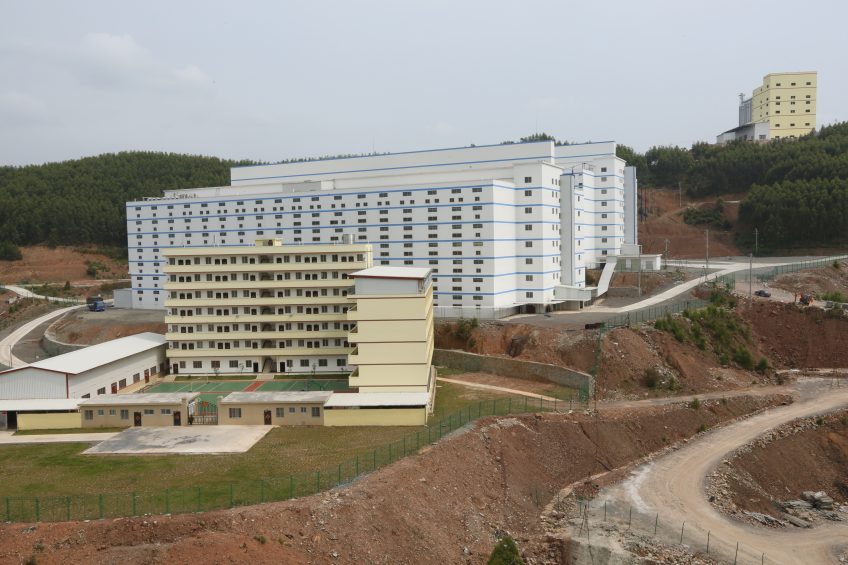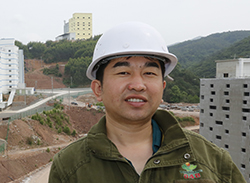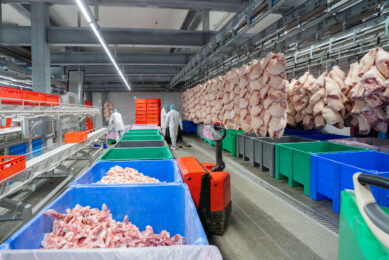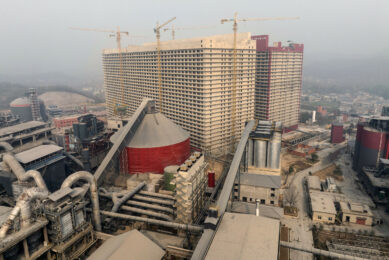Yangxiang aims high with sows on many floors

Chinese pig company Yangxiang go where few have gone before: with the construction of pig farms with 7, 9 or even 13 floors. The multi-storey pig houses are designed to keep pathogens out and to save costs on a scale never achieved before.
At the end of a winding road that goes on for miles, there they are. Gradually rising up behind the horizon, far away from the madding crowds, the giant multi-storey pig buildings come into sight. Owned by the Chinese pig production company Yangxiang, these pig houses are impressive in their own right.
Visitors will first notice the feed mill, then 2 multi-storey pig farms of 7 stories each, which have been in use since mid 2017. Just behind that, 2 multi-storey farms each with 9 floors – still under construction. All 4 pig buildings look identical, apart from the altitude.
|
Yangxiang and biosecurity
From time to time, they pop up on the Web: pictures of a giant pig building project – and each and everyone always reacts with likes and shares. In reality, the experience at the location near Guigang surpasses all expectations. The multi-storey pig houses are huge, neatly finished tall buildings, which could fit perfectly into any residential area of a city. Yangxiang has one of them in northern China – and the company is currently building a series near Guigang.
Aiming high has been a very conscious choice and the company has 2 reasons for it:
- animal health
- labour efficiency.

Movement of pathogens between pig houses
Contrary to conventional, low pig houses, the chances are considered to be much smaller that pathogens can move from one pig house to the other through ventilation air. In low buildings, after all, pig houses are being built parallel to each other and outgoing air could relatively easily hop from one pig house to another.
Movement of air, sows and people
In the Yangxiang pig houses, the air enters on the side of the buildings and will leave the building about 15m above the ceiling. There are air inlets on every floor (each housing 1,000 sows) and mixing of incoming air simply doesn’t happen, just like animals as sows stay on their floor for the rest of their lives. Staff also only work on their own floor.
Yangxiang performs its own breeding, per multi-storey pig house, which means that no new breeding gilts need to be brought in. After weaning, the piglets will leave the building using a separate elevator.

Protocol for a disease outbreak?
Should there be a disease outbreak, then that will remain isolated on one floor only. Add to this the fact that in the wide surroundings there are no other pig farms plus, as an additional insurance, there is filtration of all incoming air. On top of that, staff will have to stay in quarantine for 48 hours, at 2km distance from the pig houses, before they are permitted entrance on the farm premises. It is just difficult to think of applying any more measures to keep pathogens out.
Animal health management
The Chinese are very aware of the importance of decent animal health and animal welfare management. For that reason, Yangxiang chose to work with Specific Pathogen Free (SPF) pigs and no penny has been spared to keep pathogens out. In large areas of China, a lot of antibiotics are being used, as disease pressure is usually high. The Yangxiang multi-storey pig houses are located 500m above sea level, far away from other pig farms.

A testimonial to animal health can be found in the two seven-storey buildings. In these houses, having SPF sows, until mid-March 2018, it hadn’t been necessary to use any antibiotics. Farm manager Zong Ai Ming reports that it is sufficient to treat injured animals with iodine. From a veterinary perspective, piglets will be injected twice; the first being an iron injection, the second being a vaccination against M. hyo. At around day 6 the male piglets will be castrated.
Yangxiang and animal welfare
Animal welfare is only gradually becoming a topic of concern in China. Nevertheless, at the construction, the builders had European designs in the back of their minds in terms of pen sizes. Attention for animal welfare can be seen as well in the choice for group housing for gestating sows. The farm chose to keep the sows in group housing during gestation as Yangxiang believe the animals will be in better shape at farrowing and because parturition is usually easier. In total 35 days after insemination, the gestating sows will go into a group housing area with free access stalls, until the animals are allowed to enter the farrowing rooms.
Talking about animal welfare, newborn piglets are not forgotten. For them, there are heated pens with an additional heat lamp to keep the place warm. A micro climate thus is created right next to the sows, for whom the maximum temperature should be 24ºC.
In all these respects, the inside of the multi-storey pig houses is comparable to pig houses anywhere else on the planet.

Costs of building high
According to the owner of Yangxiang, who wishes to stay anonymous, economy of scale, efficiency as well as healthy animals are the key pillars of success in a free pig market. This philosophy has resulted in aiming high for pig houses – a challenging and more expensive manner to keep sows than in a conventional pig house.
Costs: Keeping temperatures optimal
Building costs of the multi-storey pig houses are about € 2,000 per sow place – or a total of € 18 million per nine-storey pig house. In comparison the investment for a conventional, low pig house, would be € 500/sow lower. The buildings do have a lot of luxury equipment – think of pad cooling, virus filtration as well as air conditioning. The latter is related to the fact that temperatures in the lactation house had better not exceeded 24ºC; for the gestation house, 22.5ºC should be the maximum. In this southern part of China, therefore cooling down is usually more important than heating, as during winter, the minimum temperature does not get lower than 5ºC. In summer, temperatures of close to 40ºC can usually be reached.
Costs: Staff / pig ratio
The additional investments for construction are usually earned back once it is operational, explains farm manager Zong Ai Ming. Inside the multi-storey pig houses, 4 members of staff are sufficient per 1,000 sows. This is where the compactness of 1 floor pays off. In the case of conventional buildings, usually 10 employees are used with a similar number of sows.
Cost price per weaner dropped
The grower phase takes place on finishing farms. First piglets, from the multi-storey building having 7 floors, were finished in December 2017. Cost price of these animals was initially € 25 per 7kg piglet. Now initial start-up problems have been overcome, cost price of a weaner pig has dropped to just over € 23 by the beginning of this year.

Targeted and organised production
Yangxiang’s focus is on piglet production. After weaning, the piglets will be sent to contract farmers who will grow and finish the animals. Yangxiang will continue to own those pigs and provides knowledge, feed and other equipment, making sure that the contract farmer can focus on pig house management and taking care of the animals. On average, contract farmers receive € 30 per pig, for the grow-finishing phase from 7 to 120kg.
Motivating staff to achieve goals
In order to achieve all these goals, staff at the Yangxiang farm are working in a very professional and organised manner. Whether it is at the head office, in the meeting room close to the multi-storey pig houses or in the quarantine area, everywhere there are banners and flags to be seen with the production and cost price goals. They state “3028 in 2024”, which translates as: In 2024, there should be 30 piglets weaned per sow per year and 28 pigs at the slaughterline, per sow per year. Average production at the moment is at 27.6 weaned pigs per sow per year. Cost price for a pig with a liveweight between 110 and 120kg is about € 1.35/kg at Yangxiang. This should come down vastly in the years to come to reach € 1.15/kg liveweight in 2024.
Compare that to 5 years ago and it’s clear how fast developments go at Yangxiang. Back then, the company’s sows were weaning 22 piglets annually. Similarly, the cost price for a finisher pig was € 1.79 per kg liveweight. One reason for the rapid improvement is that staff are being encouraged to always improve technical results. At the end of the year, a nice bonus is awaiting them should all targets be met. All this has resulted in a tremendous growth of sow numbers: Yangxiang’s sow inventory has tripled over the last few years, to a total of 90,000 sows in the beginning of 2018.
Results so far
The 2 9-storey buildings, under construction in mid-March, shall be put into use in mid-2018. The first batches of piglets from the 7-storey pig houses were delivered to the market in early 2018. Technical results of pig production in multi-storey houses so far have been very promising.

Before the sows are admitted to the farrowing pens, their condition is monitored. This is done by weighing them and measuring their backfat thickness. In the floor of each level, there are scales determining the sows’ weights as soon as they walk across. Next, their nutrition programme is being determined on the basis of that outcome.
The sows are dry fed and get their water through a separate drinking nipple. The feed is produced at a nearby feed mill which is distributed to the pig houses using a air pressure tube, making transport vehicles redundant.
Yangxiang and the future
And there is more to come. 2 multi-storey buildings, together accounting for 18,000 sows, will go into production in the middle of 2018. Within 2 years, Yangxiang will put 2 multi-storey pig houses with 13 floors into use, with a total capacity of another 26,000 sows. The foundation for these new buildings has already been laid.

Growth not the only goal
Nevertheless, growth is not a goal in itself, the owner has indicated. What matters to the company is quality as well as satisfied customers in various different segments of the market. Owning 6,000 boars, Yangxiang is one of the world’s larger artificial insemination (AI) providers. In addition, the company delivers compound feed to other pig producing companies. On top of that, both the AI as well as the feed company come with their own consulting services. Those advisors will assist farmers to enhance their reproductive results and improve their performance in the pig house. There is definitely room for improvement, keeping in mind that on average, Chinese pig farms wean 22 piglets per sow per year. Especially AI and breeding assistance is important to Yangxiang – in this market, competition is still relatively absent.
The growth is being paid for with own money. This is possible because for a long time, the profits were high in China’s pig production. In the beginning of 2016, profit margins amounted to be about € 150 per finished pig, with revenues being around € 3 per kg liveweight. In March 2018, however, those prices had dropped to € 1.41 per kg. All in all, after tax, Yangxiang made a profit of € 103 million in 2017.
Introduction of Big Data
In the years to come, Big Data shall be introduced on the pig farm. This is why there are currently trials being done around a technology of facial recognition in pigs. This technology is currently being developed by the company Yingzi. It is aimed at further optimising pig management, so technical results can improve further.
Additions to the complexA new feed mill is located about 100m away from the multi-storey pig houses. This facility will start trial rounds as from late April 2018. Once in operation, it will have a capacity of 84,000 tonnes feed annually. The investment for the feed mill alone is € 1.93 million. Yangxiang will buy raw materials centrally for all its pig farms, mostly on the futures market. The most important ingredients are corn, soybeans, sorghum, barley and fish meal. The feed mill shall produce 11 different types of diets. These will include sow diets, a pre-starter as well as a boar diet for the nearby AI centre. Most raw materials will be trucked in from the north of China, although a part will be imported. The pig houses that have been ready since 2017 temporarily obtain their feed from a different feed mill. Yangxiang also invests in a central manure processor, as Chinese environmental laws have become strict in recent years, with regards to emissions (odours) and manure. The manure will be collected from all six multi-storey pig houses, through a sewer system per floor. The manure shall go to the processor, which was under construction in March 2018. The intention is to first separate the thick fraction from the thin fraction. The thick fraction will be sold off as organic manure. The thin fraction will be cleansed in order to dispose of it in the mountains surrounding the processing facility. Yangxiang needs a permit for that. |

Read more about pig countries all over the world in our Country Focus Tool.


 Profile
Profile









